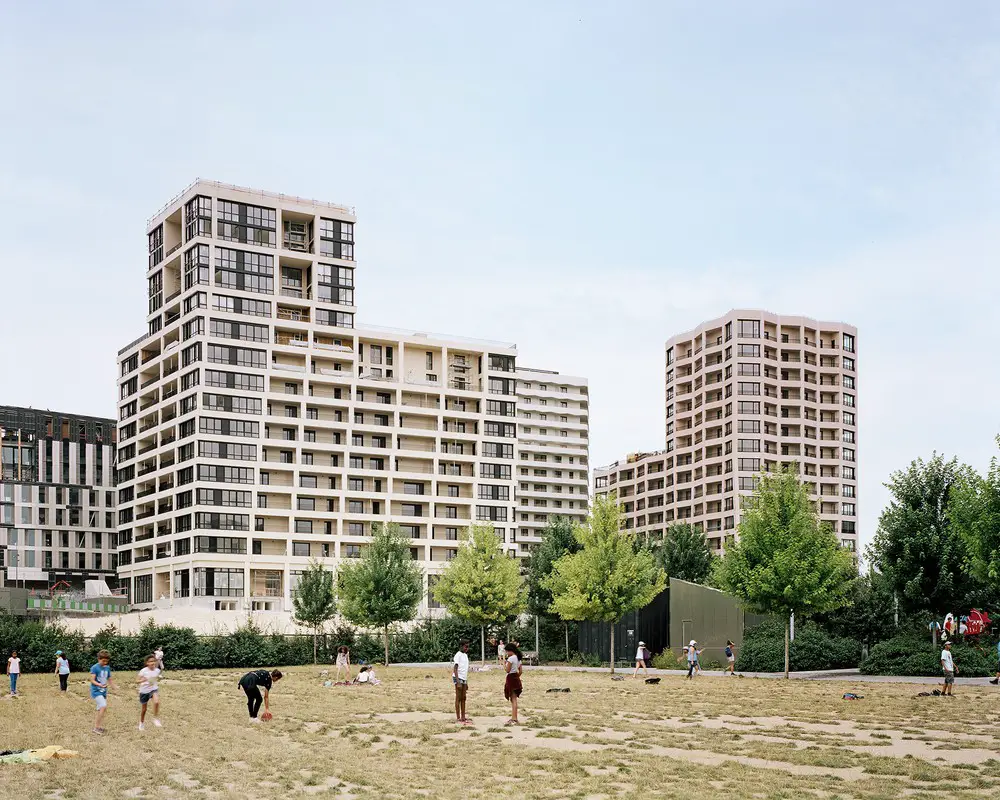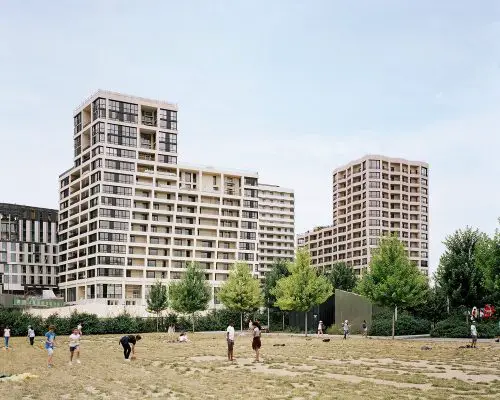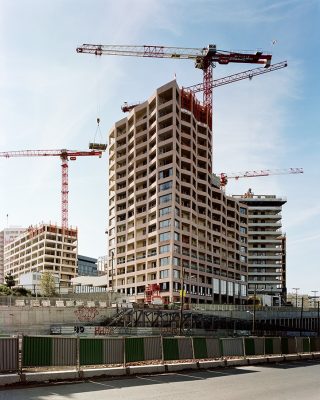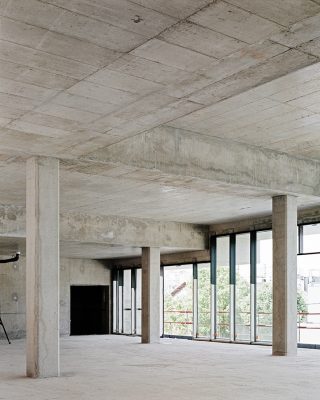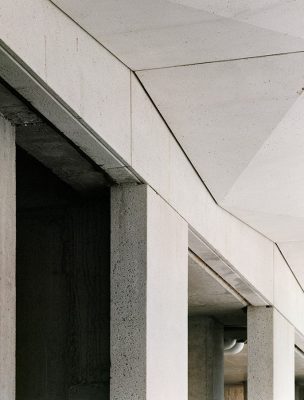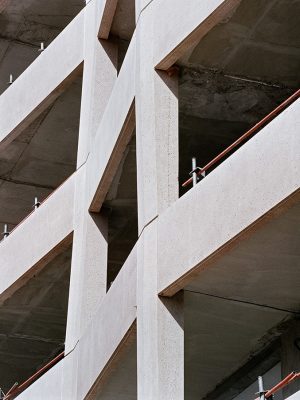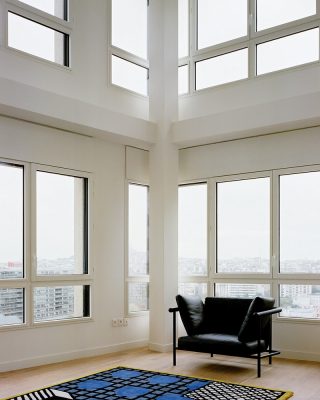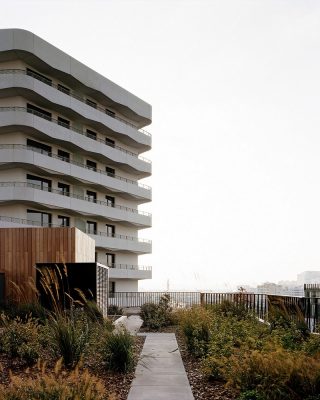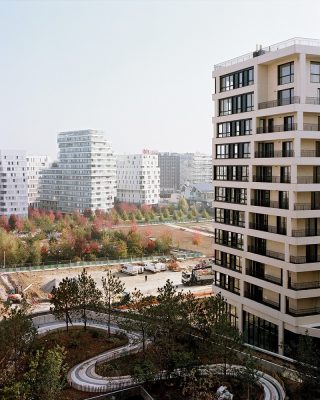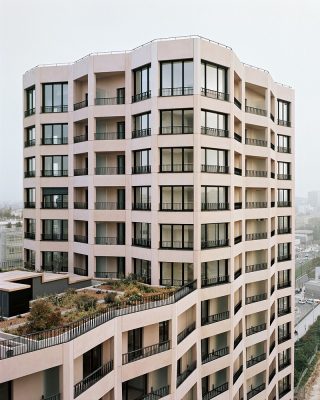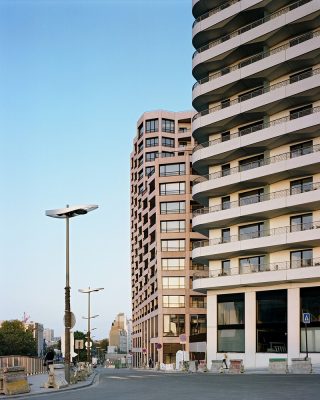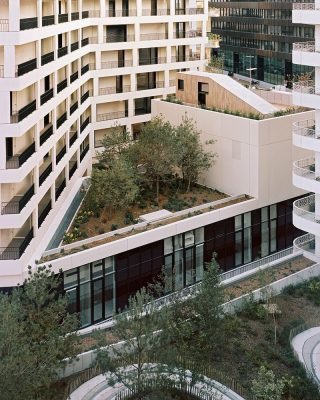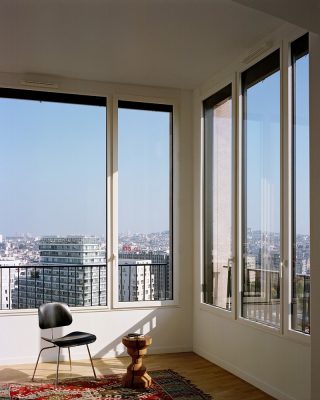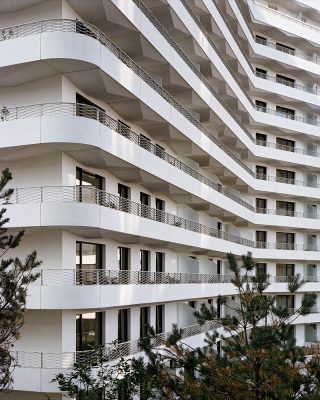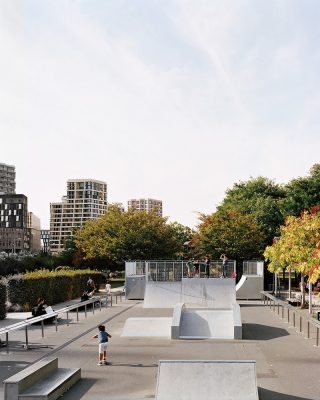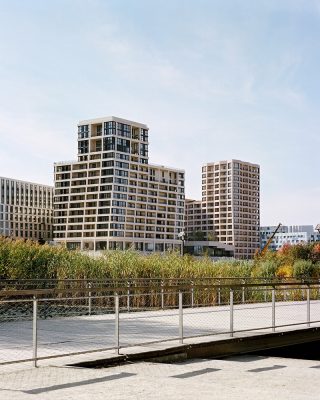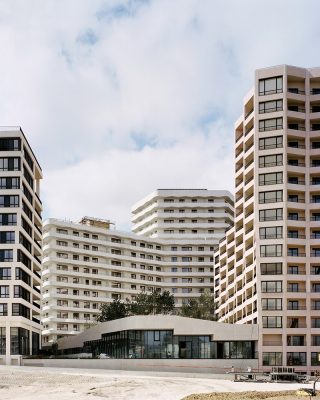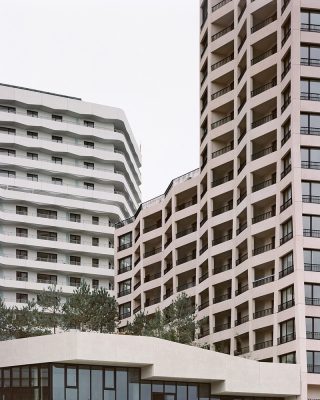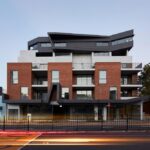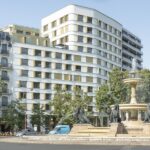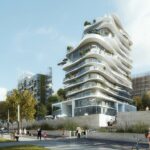The Cultural Block, Parisian Cinema, Community Center, Concert Space, Dance Studios, Apartments, Shops, Images
The Cultural Block in Paris
Large Mixed-Use Development in Paris, France design by Tolila+Gilliland and TVK
6 Oct 2019
The Cultural Block
Architects: Tolila+Gilliland and TVK
Location: Rue Mstislav Rostropovitch and Allée Colette Heilbronner, 75017 Paris, France
The Cultural Block
Three residential buildings offering exceptional views of the great Parisian landscape anchor three corners of a mixed-use block. At the heart of the project is a cultural center for the new ZAC ClichyBatignolles district in Paris’ 17th arrondissement: a seven-theatre cinema and a community center.
These public volumes, anchored to the ground, give way to the public realm and are crowned with hanging gardens. Three residential blocks emerge from this base, climbing up to 50 meters. This simple distribution of masses effectively resolves the inscription of a complex program on a high-density site. Thickened facades permit a band of generous loggias around the residential blocks.
Architectural precast concrete on the buildings’ facades situate the project within the material tradition of Parisian stone and concrete and gives each of the three buildings a singular expression from the ground to the sky: the twisted form with its torqued effect (sand colored), the chiseled bar with continuous balconies (in white) and the pleated tower with its progressive fold.
The new Clichy-Batignolles neighborhood occupies a unique place in the Parisian urban landscape; it both belongs to the large open space of the city’s green belt and links the neighborhoods of the 17th arrondissement to the town of Clichy. The cultural block is emblematic of the primary axes that first shaped this territory: Rue Mstislav Rostropovitch, Boulevard Berthier, the railway tracks and the park. Despite the difficulties of being trapped between infrastructures the site has extraordinary potential to centralize uses and strengthen social connections.
The parcel also benefits from its visibility at great distances, given the overall low density of the green belt and elevated position generated by the railway topography. These corner conditions, combined with the potential for both close and distant visibility motivated the decision to concentrate the density at the corners of the site, up to a maximum height of 50 meters.
The site’s topography allowed a large part of the public program and all of the parking to be located in a partially underground podium, from which the three collective housing forms ascend. This distribution of volumes makes a clear distinction between the cultural spaces, anchored to the ground, and residential programs that expand upward, opening up to the greater landscape.
A Cultural Center
The cultural center of Batignolles occupies a strategic position at the edge of the 17th arrondissement and Martin Luther King Park, facing Boulevard Berthier and visible from the Porte de Clichy. It fronts the Paris Opera’s Ateliers Berthier, which today host the Théâtre de l’Odéon.
The block completes this cultural offering with “Les 7 Batignolles” a seven theater cinema and community center, which includes a concert space and dance studios. These public programs make the block a natural destination for the whole neighborhood.
The cultural aim of the project confers a special status at the corner of two streets, giving the public space a recognizable identity and creating a destination. In order to open the block to the public, both the community center and cinema feature transparent façades looking onto the park and a footpath at the center of the block.
This path encourages relaxing interactions between the public and residents throughout the day. It also gives access to a flexible space at the front of the cinema, a fully glazed multi-use cultural space facing the park. From this space, the public can descend into the theatres or cross through the lobby, connecting to Boulevard Berthier.
An interior street that resolves the lower level change and connects the neighborhood through the center of the site. The community center completes the gesture with a large lower-level auditorium and a dance studio that overlooks the street. An educational garden on the roof of the community center supports its programs and the cinema rooftop operates as a shared garden for residents.
Outdoor Living
The positioning of the three residential blocks at the corners of the triangular site permits views and light at every floor. The building volumes are carved to privilege diagonal views, daylight, and to maximize the number of corner units. The area of each unit is extended by an average of 14 m² of exterior space per unit with a generous balcony occupying the thickened façade (instead of the typical 9 sqm).
These spaces, effectively an additional room, provide uninterrupted views of the land scape while maintaining privacy with opaque balustrades. Here, outdoor living is possible; with a minimum depth of 1.6 m these spaces can comfortably accommodate a table and four chairs.
These external extensions of the living spaces resulted in several unique conditions, such as the double height loggias at the fifteenth floor, internal patios on the tenth, and private terraces on the eleventh. Collective terraces are also accessible to residents at the second and eleventh floors. At the second floor, for example, a large garden hangs above the cinema featuring a path meandering between the trees as if it were a vert
Geometry and Material
Designing 50 meter residential buildings (15 floors) meant that the expression of height was specifically considered in order to avoid the traditionally repetitive and static effect of stacked floors. Thus, all three buildings use the façade to create an overall sense of movement and a dynamic effect from bottom to top; from the ground to the sky.
The sand colored, or “twisted” building is conceived in an upward movement wrapping the building. This effect is produced by a regular shift in the structural span from one floor to the next. Thus, the form seems to curl upon itself, in the manner of an atmospheric movement. The pink, or “pleated” building is characterized by the gradual transition from a flat facade in the lower floors to a pleated facade on the upper floors. This articulation
gives the form a dynamic profile that changes depending on the viewing angle. The white, or “chiselled” building is best perceived from pedestrian height. The balcony soffits are carved into faceted profiles that gradually change throughout each floor. Each building also treats the last floor differently to establish a “crown.”
The desire for unity resulted in the use of prefabricated concrete on the façade of each building. This material, having great solidity and exceptional durability, allowed for a greater variety of finishes and colors.
Beyond the technical approach that justified this choice the material also places the project within the continuity of Parisian masonry. Factory fabrication has a low environmental impact because it reduces waste and simplifies on-site logistics (traffic and sound pollution).
It also allows for a greater precision over the colors of the building elements, an especially important aspect for projects of this size that have a long life span and a range of climatic conditions across the site. The buildings’ colors are inherent to their materiality, especially here, where the concrete is naturally colored by the sand and aggregates. No artificial colorants or additives tint the precast loadbearing façade system.
Landscape
The structure of the building makes it possible to imagine a geology, to invent a geography, a topography, a hydrography, an ecology, uses—a landscape. This micro-landscape invites us to explore, despite a limited site, the impression of a larger landscape (miniaturization), to travel in space and time (heterotopy), and to feel the vibration of a present multiplied in time.
An atmospheric nature is created overlooking Martin Luther King Park, an outlook onto the city and its layers of urban horizons. The creation of this nature requires great precision. The emotional construction of this landscape is a collage of images, memories, and sensations. This is translated via the forming of a wooded hill, a winding pathway, as well as views and textures that makes it possible for this living nature to climb hills or tumble down its slopes.
These gardens become supports for the history and memories of residents by staging a theater of nature and time: plants growing more luxurious and sensual with variations throughout seasons and years. The sophisticated composition of the garden creates a rich variety of uses both individual and collective.
For example, an active use like crossing the garden or a more contemplative one as when viewed from a dwelling. This physical contact with nature allows you to either garden privately on your own balcony or collectively in the communal garden, to either admire nature or engage with it, and to meet neighbors. These pockets of gardens on the rooftops are a form of nature that enriches the city which makes the city seem more hospitable.
Marbre d’ici (Marble from Here), a work of art at the heart of the project
Marbre d’ici (Marble from Here) is an artistic protocol based on transforming construction waste conceived by the artist Stefan Shankland. This collaborative effort was piloted by the artist and assisted by the construction team on site.
Secondary raw material came from prefabricated elements deemed defective and that would otherwise be discarded. The material was reduced to a powder and mixed with cement before being poured in layers. Thus, inert waste of different kinds is transformed into a new local resource: a noble material.
By focusing on the production processes over the finished product, Marble from Here gives visibility to what usually remains hidden in the city: material and human resources for the construction transformed into a precious architectural object. Marble from Here is literally the remains of crushed concrete from the project, broken down from the precast concrete and used to create a pedestrian path crossing the communal garden: a striated horizontal sculpture reminiscent of glacial formations made of rubble and crushed rock.
These monstrosities of ice that once sculpted our landscape throughout the successive ice ages recall other equally powerful contemporary phenomena—urban, industrial, economic, demographic, and social monstrosities. Phenomena, which in the Anthropocene Age, consume raw material, are influencing the climate and shaping the world.
The Cultural Block, Paris – Building Information
Mixed Program: Seven-theatre cinema with cultural space – Community center with separate concert space and dance studios – 342 residential units (153 social, 80 controlled rent and 109 market rate) – Retail space – Communal garden – Artwork
Context: Lot O8, ZAC Clichy-Batignolles
Location: Rue Mstislav Rostropovitch and Allée Colette Heilbronner 75017 Paris, France
Area: 29,240 sqm net
Budget: 54,300,000€ pretax
Performance & Certifications: RT 2012 – Paris Climate Action Plan Housing: – Label Effinergie + Profil A – European Project Laureate CoRDEES (Feder)
Status: Complete
Schedule: Delivered end of 2018
Design Team TVK: Lead architect Tolila+Gilliland: Associate architect Praxys: Landscape architect Elithis: MEP and Environmental engineer
Developer: Paris Métropole & Aménagement (ex Paris Batignolles Aménagement)
Owner: Linkcity, Nexity, SNES/Pathé, Ville de Paris
End Users: Perl, Batigere, Elogie, Vilogia, SNES/Pathé/Miroir Magique, Ville de Paris
Artwork: Marbre d’ici (Marble from Here) / Stefan Shankland
Cinema Consultant: Olivier Mouton, Marc Rouquier, Ana Moussinet
Community Center Consultant: G+
About TVK:
TVK is an international office of architecture and urban design, created by Pierre Alain Trévelo and Antoine Viger-Kohler in Paris in 2003. Trained in Paris and at Harvard, involved in teaching from the outset, they pursue an approach where theory and practice mutually respond to and enrich each other.
Through projects, research and writing they have steadily produced a singular œuvre, at once theoretical and built. Their aim is to capture the complexity and the paradoxical character of the contemporary earthly situation, in order to contribute to making it habitable.
Since its creation, TVK has acquired a strong reputation, ranking among the most recognised French agencies, and as having a singular approach among international agencies. Effectively, TVK owes its specificity to the combination of two approaches. On the one hand, TVK produces an essential architecture, in which space, geometry and building are the key elements.
The projects are both direct and rooted in the theory and history of architecture. On the other hand, TVK conducts strategic research on the major themes conditioning the design of the planet. This research is open, collective and allows the inclusion of the complexity and instability of the most urgent issues.
TVK represents the synthesis of this double approach, both essentialist and open, thereby engaging in works at all levels, from furniture to land, from the edifice to the planet. Employing about 50 people, TVK has achieved French recognition from its beginning, notably with the Palmarès des Jeunes Urbanistes in 2005 and the Nouveaux Albums des Jeunes Architectes in 2006, then international with the redevelopment of Place de la République in Paris in 2013, the transformation of E40 highway in Brussels or the redevelopment of Lausanne train station square in Switzerland.
TVK took part in the Scientific council of the Atelier International du Grand Paris (Greater Paris) until 2016, leads large scale urban projects and builds architecture throughout France. The office currently leads L’Atelier des Places du Grand Paris (Greater Paris public squares atelier).
About Tolila+Gilliland:
Tolila+Gilliland Atelier d’Architecture was founded in 2011 by architects Gaston Tolila and Nicholas Gilliland around the shared desire to design sensitive projects to serve users, through an exploration of geometry and materials. The architectural practice of Tolila+Gilliland is characterized by a great versatility of programs: housing (from the single family home to the eco-district), public buildings (shops, museums, libraries), offices, town planning and design. These projects have allowed the studio to gain experience in project management, multidisciplinary teamwork and sustainable design.
The atelier aims to propose projects which are always adapted to the specific context and conditions of each site through a careful revelation of history and geography. Tolila+Gilliland was awarded the Architecture Prize for “Prix du Moniteur pour La Première Oeuvre” in 2012 for their first work, and in 2014 by the European Center for Architecture and the Chicago Athenaeum among the 40 architects under 40 years old in Europe (EUROPE 40 UNDER 40) who “will influence the near future of European architecture, both in theory and in practice”.
Photographer © Julien Hourcade
The Cultural Block in Paris images / information received 061019
Location: Rue Mstislav Rostropovitch and Allée Colette Heilbronner 75017 Paris, France
New Paris Architecture
Contemporary Paris Architecture
Paris Architecture Design – chronological list
Architecture Tours in Paris by e-architect
Le Bon Marché, Saint-Germain-des-Près, 7th arrondissement
Design: Louis-Charles Boilleau and Gustave Eiffel
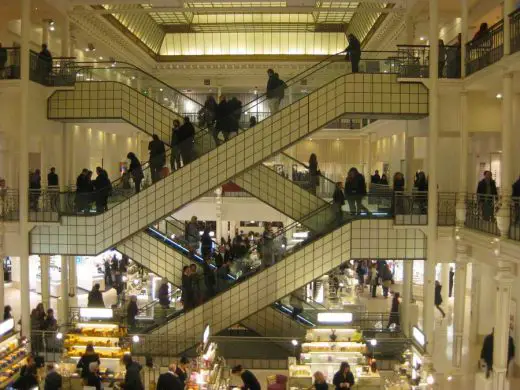
photograph © Adrian Welch
Parisian Department Store
Lafayette Department Store
Design: Manuelle Gautrand Architecture
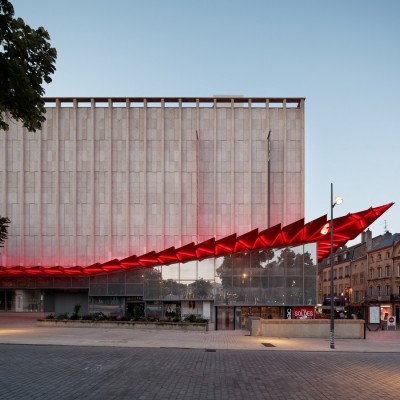
photograph : Vincent Fillon
Lafayette Department Store Paris
Magasin La Samaritaine, 77 rue de Rivoli
Design: SANAA
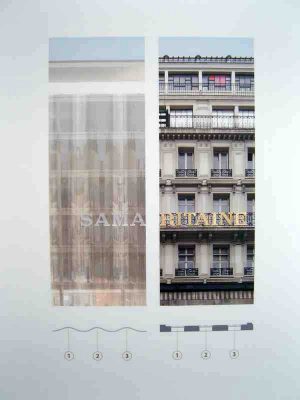
photograph © Colin Eaton
Magasin La Samaritaine Paris Store
Famous Paris Architecture
Musée du Louvre, Ie
Design: various architects
Louvre Museum Building
La Basilique du Sacré Coeur, Montmartre, XVIIIe – Sacred Heart Church building
Design: Paul Abadie Architect
Sacré Coeur Paris
Paris Buildings : buildings listed alphabetically
Comments / photos for the Cultural Block in Paris – page welcome

